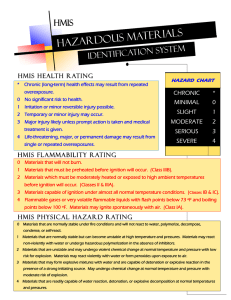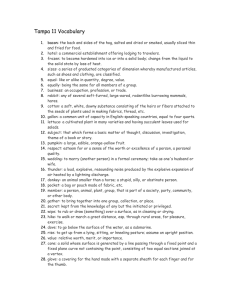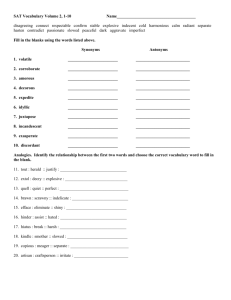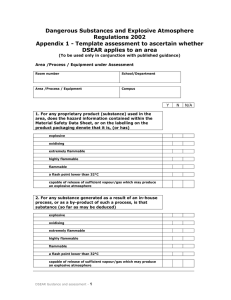Explosives Hazard Classes & Compatibility Groups (UNO)
advertisement
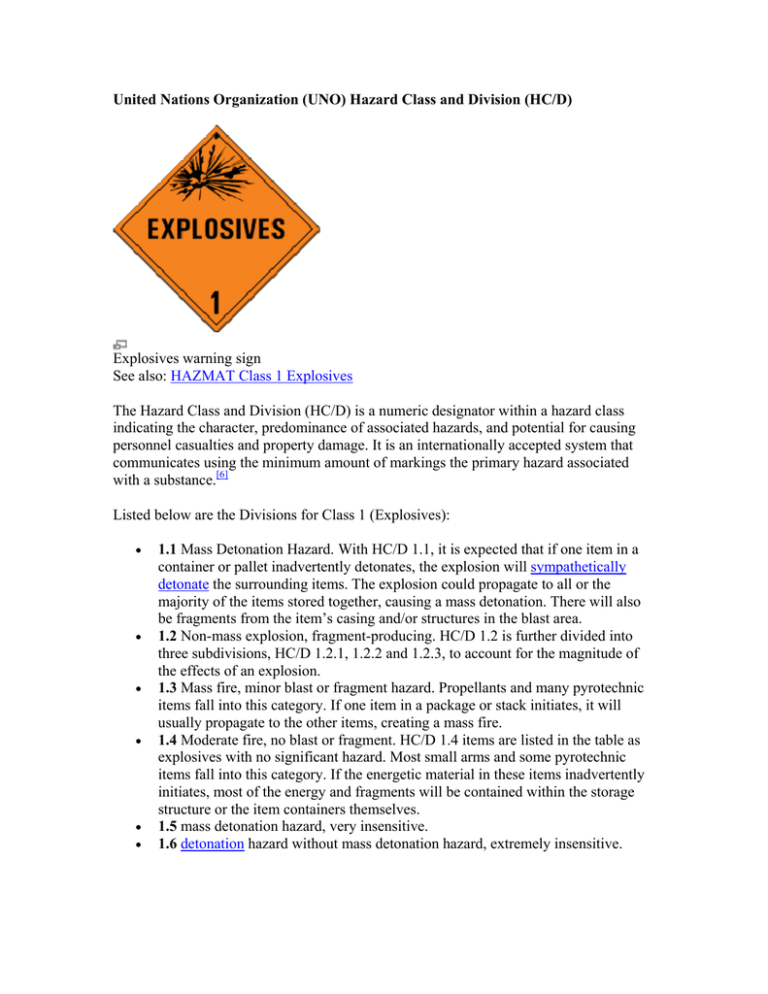
United Nations Organization (UNO) Hazard Class and Division (HC/D) Explosives warning sign See also: HAZMAT Class 1 Explosives The Hazard Class and Division (HC/D) is a numeric designator within a hazard class indicating the character, predominance of associated hazards, and potential for causing personnel casualties and property damage. It is an internationally accepted system that communicates using the minimum amount of markings the primary hazard associated with a substance.[6] Listed below are the Divisions for Class 1 (Explosives): • • • • • • 1.1 Mass Detonation Hazard. With HC/D 1.1, it is expected that if one item in a container or pallet inadvertently detonates, the explosion will sympathetically detonate the surrounding items. The explosion could propagate to all or the majority of the items stored together, causing a mass detonation. There will also be fragments from the item’s casing and/or structures in the blast area. 1.2 Non-mass explosion, fragment-producing. HC/D 1.2 is further divided into three subdivisions, HC/D 1.2.1, 1.2.2 and 1.2.3, to account for the magnitude of the effects of an explosion. 1.3 Mass fire, minor blast or fragment hazard. Propellants and many pyrotechnic items fall into this category. If one item in a package or stack initiates, it will usually propagate to the other items, creating a mass fire. 1.4 Moderate fire, no blast or fragment. HC/D 1.4 items are listed in the table as explosives with no significant hazard. Most small arms and some pyrotechnic items fall into this category. If the energetic material in these items inadvertently initiates, most of the energy and fragments will be contained within the storage structure or the item containers themselves. 1.5 mass detonation hazard, very insensitive. 1.6 detonation hazard without mass detonation hazard, extremely insensitive. To see an entire UNO Table, browse Paragraphs 3-8 and 3-9 of NAVSEA OP 5, Vol. 1, Chapter 3. [edit] Class 1 Compatibility Group Compatibility Group codes are used to indicate storage compatibility for HC/D Class 1 (explosive) materials. Letters are used to designate 13 compatibility groups as follows. A: Primary explosive substance (1.1A). B: An article containing a primary explosive substance and not containing two or more effective protective features. Some articles, such as detonator assemblies for blasting and primers, cap-type, are included. (1.1B, 1.2B, 1.4B). C: Propellant explosive substance or other deflagrating explosive substance or article containing such explosive substance (1.1C, 1.2C, 1.3C, 1.4C). These are bulk propellants, propelling charges, and devices containing propellants with or without means of ignition. Examples include single-, double-, triple-based, and composite propellants, solid propellant rocket motors and ammunition with inert projectiles. D: Secondary detonating explosive substance or black powder or article containing a secondary detonating explosive substance, in each case without means of initiation and without a propelling charge, or article containing a primary explosive substance and containing two or more effective protective features. (1.1D, 1.2D, 1.4D, 1.5D). E: Article containing a secondary detonating explosive substance without means of initiation, with a propelling charge (other than one containing flammable liquid, gel or hypergolic liquid) (1.1E, 1.2E, 1.4E). F containing a secondary detonating explosive substance with its means of initiation, with a propelling charge (other than one containing flammable liquid, gel or hypergolic liquid) or without a propelling charge (1.1F, 1.2F, 1.3F, 1.4F). G: Pyrotechnic substance or article containing a pyrotechnic substance, or article containing both an explosive substance and an illuminating, incendiary, tear-producing or smoke-producing substance (other than a water-activated article or one containing white phosphorus, phosphide or flammable liquid or gel or hypergolic liquid) (1.1G, 1.2G, 1.3G, 1.4G). Examples include Flares, signals, incendiary or illuminating ammunition and other smoke and tear producing devices. H: Article containing both an explosive substance and white phosphorus (1.2H, 1.3H). These articles will spontaneously combust when exposed to the atmosphere. J: Article containing both an explosive substance and flammable liquid or gel (1.1J, 1.2J, 1.3J). This excludes liquids or gels which are spontaneously flammable when exposed to water or the atmosphere, which belong in group H. Examples include liquid or gel filled incendiary ammunition, fuel-air explosive (FAE) devices, and flammable liquid fueled missiles. K: Article containing both an explosive substance and a toxic chemical agent (1.2K, 1.3K) L Explosive substance or article containing an explosive substance and presenting a special risk (e.g., due to water-activation or presence of hypergolic liquids, phosphides, or pyrophoric substances) needing isolation of each type (1.1L, 1.2L, 1.3L). Damaged or suspect ammunition of any group belongs in this group. N: Articles containing only extremely insensitive detonating substances (1.6N). S: Substance or article so packed or designed that any hazardous effects arising from accidental functioning are limited to the extent that they do not significantly hinder or prohibit fire fighting or other emergency response efforts in the immediate vicinity of the package (1.4S).
